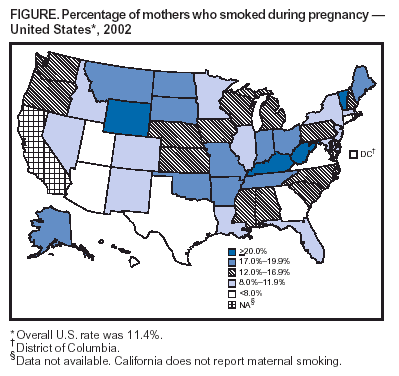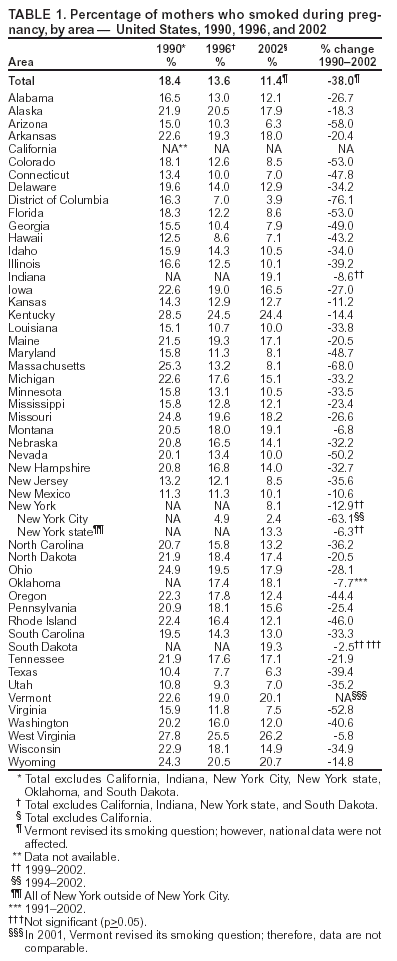Smoking During Pregnancy --- United States, 1990--2002
Download PDF Version What is PDF?
Reported by: TJ Mathews
TJ Mathews, MS, Div of Vital Statistics, National Center for Health Statistics; CC Rivera, Div of Reproductive Health, National Center for Chronic Disease Prevention and Health Promotion, CDC.
Source: Centers for Disease Control and Prevention, Smoking During Pregnancy --- United States, 1990--2002, MMWR, 53(39);911-915, October 8 , 2004
Public Domain
Table of Contents (TOC)
Article: Smoking During Pregnancy --- United States, 1990--2002Editorial Note
Tables
References
 Cigarette smoking during pregnancy adversely affects the
health of both mother and child. The risk for adverse maternal
conditions (e.g., premature rupture of membranes, abruptio
placentae, and placenta previa) and poor pregnancy outcomes
(e.g., neonatal mortality and stillbirth, preterm delivery,
and sudden infant death syndrome) is increased by maternal
smoking.1, 2, 3 Infants born to mothers who smoke
weigh less than other infants, and low birthweight (<2,500
grams) is a key predictor for infant mortality.1, 2, 4 Infertility
and conception delay also might be elevated by smoking.1
National health objectives for 2010 target an increase in
cessation to 30% among pregnant smokers during the first
trimester (objective 27-6) and abstinence from cigarettes
by 99% of women giving birth (objective 16-17).5
To assess progress toward these goals, CDC analyzed state-specific
trends in maternal smoking during 1990--2002 by using data
collected on birth certificates. This report summarizes
the results of those analyses, which indicated that whereas
participating areas observed a significant decline in maternal
smoking during the surveillance period, 10 states reported
recent increases in smoking by pregnant teens. Although
the widespread public health message to abstain from smoking
during pregnancy has helped decrease maternal smoking, to
reduce prevalence further, implementation of additional
interventions are required.
Cigarette smoking during pregnancy adversely affects the
health of both mother and child. The risk for adverse maternal
conditions (e.g., premature rupture of membranes, abruptio
placentae, and placenta previa) and poor pregnancy outcomes
(e.g., neonatal mortality and stillbirth, preterm delivery,
and sudden infant death syndrome) is increased by maternal
smoking.1, 2, 3 Infants born to mothers who smoke
weigh less than other infants, and low birthweight (<2,500
grams) is a key predictor for infant mortality.1, 2, 4 Infertility
and conception delay also might be elevated by smoking.1
National health objectives for 2010 target an increase in
cessation to 30% among pregnant smokers during the first
trimester (objective 27-6) and abstinence from cigarettes
by 99% of women giving birth (objective 16-17).5
To assess progress toward these goals, CDC analyzed state-specific
trends in maternal smoking during 1990--2002 by using data
collected on birth certificates. This report summarizes
the results of those analyses, which indicated that whereas
participating areas observed a significant decline in maternal
smoking during the surveillance period, 10 states reported
recent increases in smoking by pregnant teens. Although
the widespread public health message to abstain from smoking
during pregnancy has helped decrease maternal smoking, to
reduce prevalence further, implementation of additional
interventions are required.
Data for the analyses were collected on birth certificates and reported by 49 reporting states, the District of Columbia (DC), and New York City (NYC) to CDC’s National Vital Statistics System, operated by the National Center for Health Statistics. Data on maternal smoking in California were not included because the state’s birth certificate does not collect this information in the standard format. Not all states had data available for the entire observation period (1990--2002). To obtain statistically reliable prevalences for smoking during pregnancy among teen mothers by state, 2 years of data were averaged and compared for three periods (i.e., 1990--1991, 1995--1996, and 2001--2002). All differences are statistically significant (p<0.05) unless otherwise noted.
In 2002, smoking during pregnancy was reported by 11.4% of all women giving birth in the United States, a decrease of 38% from 1990, when 18.4% reported smoking (Figure and Table 1).3 From 1990 to 2002, all 44 states (and DC) with comparable data for the entire observation period reported significant declines in maternal smoking (Table 1). However, the declines were variable, ranging from 5.8% in West Virginia (from 27.8% in 1990 to 26.2% in 2002) to 68.0% in Massachusetts (from 25.3% in 1990 to 8.1% in 2002).

Since 1990, maternal smoking for females aged 15--19 years has fluctuated. Every year from 1996 through 2001, these mothers had the highest percentage of smoking during pregnancy than any other age group.3, 6 However, in 2002, the percentage of maternal smokers aged 15--19 years (16.7%) was the same as that for women aged 20--24 years, with the highest percentage observed among women aged 18--19 years (18.2%).
Of 45 states (and DC) where maternal smoking percentages were calculated for teen mothers during both 1990--1991 and 1995--1996, a total of 34 states had significant declines (Table 2). Of the 45 reporting states, DC, and NYC, where maternal smoking percentages could be calculated for teen mothers for both 1995--1996 and 2001--2002, a total of 16 states and NYC had significant declines, but 15 states had significant increases for teen maternal smoking. Of these 15 states, 10 had a complete trend reversal from a significant decrease from 1990--1991 to 1995--1996 to a significant increase from 1995--1996 to 2001--2002.
Thirteen states had consistent and significant declines among pregnant women aged 15--19 years, both from 1990--1991 to 1995--1996 and from 1995--1996 to 2001--2002; four states had significantly higher teen smoking percentages in 2001--2002, compared with 1990--1991.
Smoking during pregnancy has declined in the United States, in response to public education and public health campaigns.1 Neonatal health-care costs attributable to maternal smoking in the United States have been estimated at $366 million per year.4 Smoking-cessation programs remain a crucial strategy for preventing poor birth outcomes and decreasing the social and financial costs of smoking during pregnancy.
The findings in this report are subject to at least two limitations. First, no data are presented from California, where 13.2% of U.S. births occurred in 2002, but smoking is not reported on birth certificates in the standard format. However, California annually samples mothers aged >15 years through its Maternal and Infant Health Assessment program. Data are stratified by age, region, maternal education, and ethnicity and weighted so that results can be generalized statewide. In 1999, maternal smoking prevalence was 11.5%, lower than the 12.6% reported for the United States; among teen mothers in California aged 15--19 years, smoking prevalence was 16.7%,7 compared with 18.1% for the United States. Second, prenatal smoking is underreported on birth certificates.1 Underreporting might be related to the wording of the smoking question, the timing of the data collection (e.g., during prenatal care versus after the live birth), and the stigma associated with smoking during pregnancy, particularly in cases of poor birth outcome. However, despite underreporting, the trends and variations in smoking derived from birth certificate data have been confirmed with data from other sources (e.g., National Survey of Family Growth and Pregnancy Risk Assessment Monitoring System).8
 Changes in the smoking question on the birth certificate can help clarify
smoking behavior during pregnancy. On the basis of a study of alternative
smoking questions in California,9 the question on maternal
smoking has been redesigned for the revised U.S. standard certificate
of live birth. The new question on smoking during pregnancy asks whether
the mother smoked during the 3 months before pregnancy and during each
trimester of pregnancy, clarifying the time of initiation and duration
of smoking and providing data on women who quit smoking early in pregnancy.
Changes in the smoking question on the birth certificate can help clarify
smoking behavior during pregnancy. On the basis of a study of alternative
smoking questions in California,9 the question on maternal
smoking has been redesigned for the revised U.S. standard certificate
of live birth. The new question on smoking during pregnancy asks whether
the mother smoked during the 3 months before pregnancy and during each
trimester of pregnancy, clarifying the time of initiation and duration
of smoking and providing data on women who quit smoking early in pregnancy.
Vermont implemented a revised smoking question on its birth certificate in 2000, and data for 2001--2002 indicated higher percentages because of more complete identification of smoking during pregnancy.10 The impact from this change on national data was negligible because Vermont accounts for less than 0.2% of all U.S. births. All states are expected to revise their smoking questions, resulting in discontinuity of data such as those in this report, but improving accuracy of reporting.
Women who quit smoking before or during pregnancy can substantially reduce or eliminate risks to themselves and their infants.1 The National Partnership to Help Pregnant Smokers Quit includes CDC and approximately 60 other organizations, working to ensure that health-care providers assess smoking status before, during, and after pregnancy and provide best-practice counseling on smoking cessation. Evidence suggests that specific cessation programs have been at least partly successful.6 However, not all women have responded to this public health message;1 further efforts are needed to persuade these women of the health risks posed to their infants and themselves from smoking during pregnancy.


1. US Department of Health and Human Services, Public Health Service. Women and smoking: a report of the Surgeon General. Washington, DC: Office of the Surgeon General; 2001.
2. Mathews TJ, Menacker F, MacDorman MF. Infant mortality statistics from the 2001 period linked birth/infant death data set. Natl Vital Stat Rep 2003;52(2):1--28.
3. Martin JA, Hamilton BE, Sutton PD, Ventura SJ, Menacker F, Munson ML. Births: final data for 2002. Natl Vital Stat Rep 2003;52(10):1--113.
4. Adams EK, Miller VP, Ernst C, Nishimura BK, Melvin C, Merritt R. Neonatal health care costs related to smoking during pregnancy. Health Econ 2002;11:193--206.
5. US Department of Health and Human Services. Healthy people 2010 (conference ed, in 2 vols). Washington, DC: US Department of Health and Human Services; 2000.
6. Mathews TJ. Smoking during pregnancy during the 1990s. Natl Vital Stat Rep 2001;49(7):1--14.
7. CDC. Smoking-attributable mortality, morbidity, and economic costs (SAMMEC): adult and maternal and child health software, 2002. Atlanta, GA: U.S. Department of Health and Human Services, CDC; 2004. Available at http://www.cdc.gov/tobacco/sammec.
8. Ventura SJ, Hamilton BE, Mathews TJ, Chandra A. Trends and variations in smoking during pregnancy and low birth weight: evidence from the birth certificate, 1990--2000. Pediatrics 2003;111:1176--80.
9. Kharrazi M, Epstein D, Hopkins B, et al. Evaluation of four smoking questions. Pub Health Rep 1999;114:60--70.
10. Hooley C, McCoy R. Changing the standards . . . the Vermont Experience. In: Proceedings of the 2003 National Association for Public Health Statistics and Information Systems and the Vital Statistics Cooperative Program project directors joint meeting; June 10, 2003.


